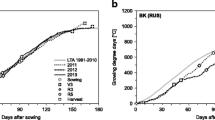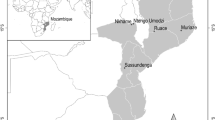Abstract
Biological nitrogen fixation with the soybean crop can be improved by seed inoculation with superiorBradyrhizobium strains, but factors that reducethe population of inoculated bradyrhizobiaon the seedwill directly affect the efficiency of the process. Seed treatment with fungicides has been broadly practiced as cheap insurance against seed-and soil-borne pathogens, but toxicity of most fungicides to bradyrhizobia has often been underestimated. The compatibility between seed treatment with fungicides in single or mixed applications (including Benomyl, Captan, Carbendazin, Carboxin, Difenoconazole, Thiabendazole, Thiram, Tolylfluanid) and bradyrhizobial inoculants was examined in laboratory, greenhouse and field experiments during five crop seasons in Brazil. Bacterial survivalon the seeds was severely affected by all fungicides, resulting in mortalities of up to 62% after only 2 h and of 95% after 24 h. Fungicides also reduced nodule number, total N in grains and decreased yield by up to 17%. The toxic effects of fungicides were more drastic in sandy soils without soybean inoculation and cropping history, reducing nodulation by up to 87%, but were also important in areas with established populations of soybean bradyrhizobia. Therefore, fungicides should be used only when the seeds or soil are contaminated with pathogens, otherwise biological N2 fixation may be severely affected.
Similar content being viewed by others
References
Aamil, M., Zaidi, A., and Khan, M.S. 2005. Fungicidal impact on chickpea-Mesorhizobium symbiosis.Journal of Environmental Science and Health, Part B39: 779–790.
Andrade, D.S. and Hamakawa, P.J. 1994. Estimativa do número de células de rizóbio no solo e inoculantes por infecção em planta. In:Manual de Métodos Empregados em Estudos de Microbiologia Agrícola. Hungria, M. and Araujo, R.S., eds. Embrapa-SPI, Brasilia, DF, pp. 63–94.
Andrés, JA., Correa, N.S., and Rosas, S.B. 1997. Survival and symbiotic properties ofBradyrhizobium japonicum in the presence of thiram: isolation of fungicide resistant strains.Biology and Fertility of Soils 26: 141–145.
Araújo, F.F., Henning, A.A., and Hungria, M. 2005. Phytohormones and antibiotics produced byBacillus subtilis and their effects on seed pathogenic fungi and on soybean root development.World Journal of Microbiology & Biotechnology 21: 1639–1645.
Bardin, S.D., Huang, H.-C., Pinto, J., Amundsen, E.I., and Erickson, R.S. 2004. Biological control ofPythium damping-off of pea and sugar beet byRhizobium leguminosarum bv.viceae. Canadian Journal of Botany 82: 291–296.
Bikrol, A., Saena, N., and Singh, K. 2005. Response ofGlycine max relation to introgen fixation as influenced by fungicide seed treatment.African Journal of Biotechnology 4: 667–671.
Campo, R.J. and Hungria, M. 2000. Compatibilidade do uso de inoculantes e fungicidas no tratamento de sementes de soja. Embrapa Soja, Londrina, 32p. (Embrapa Soja Circular Técnica, 26).
Cattelan, A.J. and Hungria, M. 1994. Nitrogen nutrition and inoculation. In:Tropical Soybean, Improvement and Production. FAO, Org. Embrapa-CNPSo, Londrina pp. 201–215. (FAO Plant Production and Protection Series, No. 27).
Curley, R.L. and Burton, J.C. 1975. Compatibility ofRhizobium japonicum with chemical seed proteetants.Agronomy Journal 67: 807–808.
Dunfield, K.E., Siciliano, S.D., and Germida, J.J. 2000. The fungicides thiram and captan affect the phenotypic characteristics ofRhizobium leguminosarum strain C1 as determined by FAME and Biolog analyses.Biology and Fertility of Soils 31: 303–309.
Embrapa. 2004. Tecnologias de produção de soja — Paraná 2005. Londrina, Embrapa Soja 224p. (Sistemas de Produção 5).
Embrapa. 2006. Tecnologias de produção de soja — Regiao Central do Brasil — 2007. Londrina, Embrapa Soja, Embrapa Cerrados, Embrapa Agropecuaria Oeste. 225p. (Sistemas de Producao 11).
Fabra, A., Angelini, J., Donolo, A., Permigiani, M., and Castro, S. 1998. Biochemical alterations inBradyrhizobium sp USDA 3187 induced by the fungicide Mancozeb.Antonie van Leeuwenhoek 73: 223–228.
Fehr, W.R. and Caviness, C.E. 1977. Stages of soybean development. Ames, Iowa State University. (Special report, 80).
Giller, K.E. 2001.Nitrogen Fixation in Tropical Cropping Systems. Wallingford, UK, CABI Publishing. 448p.
Guene, N.F.D., Diouf, A., and Gueye, M. 2003. Nodulation and nitrogen fixation of field grown common bean(Phaseolus vulgaris) as influenced by fungicide seed treatment.African Journal of Biotechnology 2: 198–201.
Gupta, S.B., Rawat, A.K., and Khare, A.K. 1988. Effect of preand post-inoculation seed treatment with fungicides on nodulation and grain yield of soybean.Legume Research 11: 167–172.
Henning, A.A. 2004. Patologia e tratamento de sementes: noções gerais. Londrina, Embrapa Soja. 51p. (Embrapa Soja. Documentos, 235).
Huang, H.-C. and Erickson, R.S. 2007. Effect of seed treatment withRhizobium leguminosarum onPythium damping-off, seedling height, root nodulation, root biomass, shoot biomass, and seed yield of pea and lentil.Journal of Phytopathology 155: 31–37.
Hungria, M. and Campo, R.J. 2007. Inoculantes microbianos: situação no Brasil. In:Biofertilizantes en Iberoamérica: Visión Técnica, Científica y Empresarial. Izaguirre-Mayoral, M.L., Labandera, C., and Sanjuan, J., eds. Montevideo, Cyted/Biofag. pp. 22–31.
Hungria, M., Campo, R.J., and Mendes, I.C. 2007. A importância do processo defixação biológica do nitrogênio para a cultura da soja: componente essencial para a competitividade do produto brasileiro. Londrina, Embrapa Soja. 80p. (Embrapa Soja. Documentos, 283).
Hungria, M., Campo, R.J., Mendes, I.C., and Graham, P.H. 2006a. Contribution of biological nitrogen fixation to the N nutrition of grain crops in the tropics: the success of soybean(Glycine max L. Merr.) in South America. In:Nitrogen Nutrition and Sustainable Plant Productivity. Singh, R.P., Shankar, N., and Jaiwal, P.K., eds. Houston, Texas, Studium Press, LLC. pp. 43–93.
Hungria, M., Franchini, J.C., Campo, R.I., Crispino, C.C., Moraes, J.Z., Sibaldelli, R.N.R., Mendes, I.C., and Arihara, J. 2006b. Nitrogen nutrition of soybean in Brazil: contributions of biological N2 fixation and of N fertilizer to grain yield.Canadian Journal ofPlant Science 86: 927–939.
Hungria, M., Franchini, J.C., Campo, R.I., and Graham, P.H. 2005. The importance of nitrogen fixation to soybean cropping in South America. In:Nitrogen Fixation: Origins, Applications and Research Progress. Newton, W.E., ed., v.4, Nitrogen fixation in agriculture, forestry, ecology and the environment. Werner, W. and Newton, W.E., eds. Dordrecht, Amsterdam, Springer: pp. 25–42.
Hungria, M., Nishi, C.Y.M., Cohn, J., and Stacey, G. 1996. Comparison between parental and variant soybeanBradyrhizobium strains with regard to the production of lipochitin nodulation signals, early stages of root infection, nodule occupancy, and N2 fixation rates.Plant and Soil 186: 331–341.
Hungria, M. and Vargas, M.A.T. 2000. Environmental factors impacting N2 fixation in legumes grown in the tropics, with an emphasis on Brazil.Field Crops Research 65: 151–164.
Kataria, H.R., Yadav, J.S., Garg, F.C., and Grover, R.K. 1985. Inactivation of seed-treatment fungicides byRhizobium. Pesticide Science 16: 337–340.
Kyei-Boahen, S., Slinkard, A.E., and Walley, F.L. 2001. Rhizobial survival and nodulation of chickpea as influenced by fungicide seed treatment.Canadian Journal of Microbiology 47: 585–589.
Pavan, M.A., Bloch, M.F., Zempulski, RD., Miyazawa, M., and Zocoler, D.C. 1992. Manual de analise química do solo e controle de qualidade. Londrina, Brasil, Instituto Agronômico do Paraná. 40 p. (Circular 76).
Pudelko, K. and Madrzak, C.J. 2004. Influence of fungicide Funaben on nodulation of soybean [Glycine max (L.) Merr.] in the field conditions.Journal of Plant Protection Research 44: 155–159.
Pueppke, S.G. 1996. The genetic and biochemical basis for nodulation of legumes by rhizobia.Critical Reviews in Biotechnology 16: 1–51.
Revellin, C., Leterme, P., and Catroux, G. 1993. Effect of some fungicide treatments on the survival ofBradyrhizobium japonicum and on the nodulation and yield of soybean [Glycine max (L) Merr.].Biology and Fertility of Soils 16: 211–214.
Rose, A.H. 1989. Influence of the environment on microbial lipid composition. In:Microbial Lipids. Ratledge, C. and Wilkinson, S.G., eds. Academic Press, London. pp. 525–535.
SAS Institute. 2001. SAS user’s guide, statistics, version 8.2, 6th ed. Cary, NC, SAS Institute. Unkovich, M.J. and Pate, J.S. 2000. An appraisal of recent field measurements of symbiotic N2 fixation by annual legumes.Field Crops Research 65: 211–228.
van Kessel, C. and Hartley, C. 2000. Agricultural management of grain legumes; has it led to an increase in nitrogen fixation?Field Crops Research 65: 165–181.
Vincent, J.M. 1970.A Manual for the Practical Study of Root Nodule Bacteria. Blackwell Scientific Publications, Oxford. 119 p. (IBP Handbook, 15).
Walsh, U.F., Moënne-Loccoz, Y., Tichy, H.-V., Gardner, A., Corkery, D.M., Lorkhe, S., and O’Gara, F. 2003. Residual impact of the biocontrol inoculantPseudomonas fluorescens F113 on the resident population of rhizobia nodulating a red clover rotation crop.Microbial Ecology 45: 145–155.
Author information
Authors and Affiliations
Corresponding author
Rights and permissions
About this article
Cite this article
Campo, R.J., Araujo, R.S. & Hungria, M. Nitrogen fixation with the soybean crop in Brazil: Compatibility between seed treatment with fungicides and bradyrhizobial inoculants. Symbiosis 48, 154–163 (2009). https://doi.org/10.1007/BF03179994
Received:
Accepted:
Issue Date:
DOI: https://doi.org/10.1007/BF03179994




